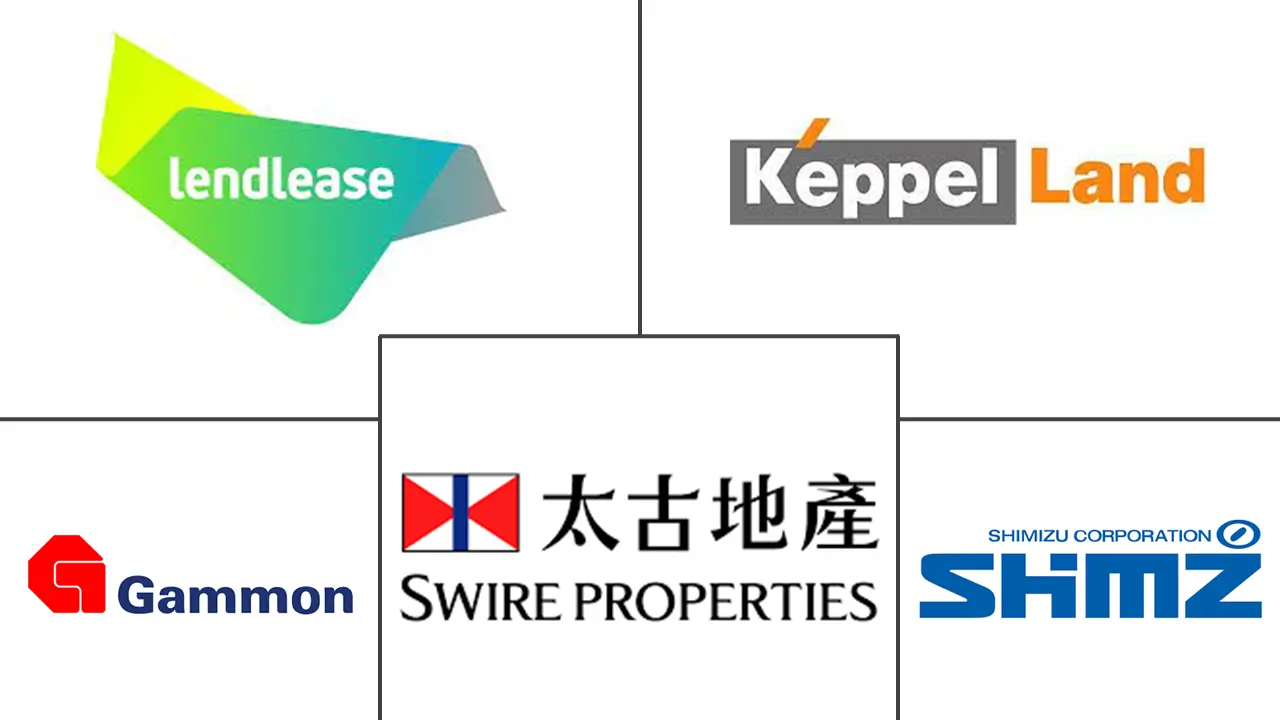Asia-Pacific Green Buildings Market Size and Share
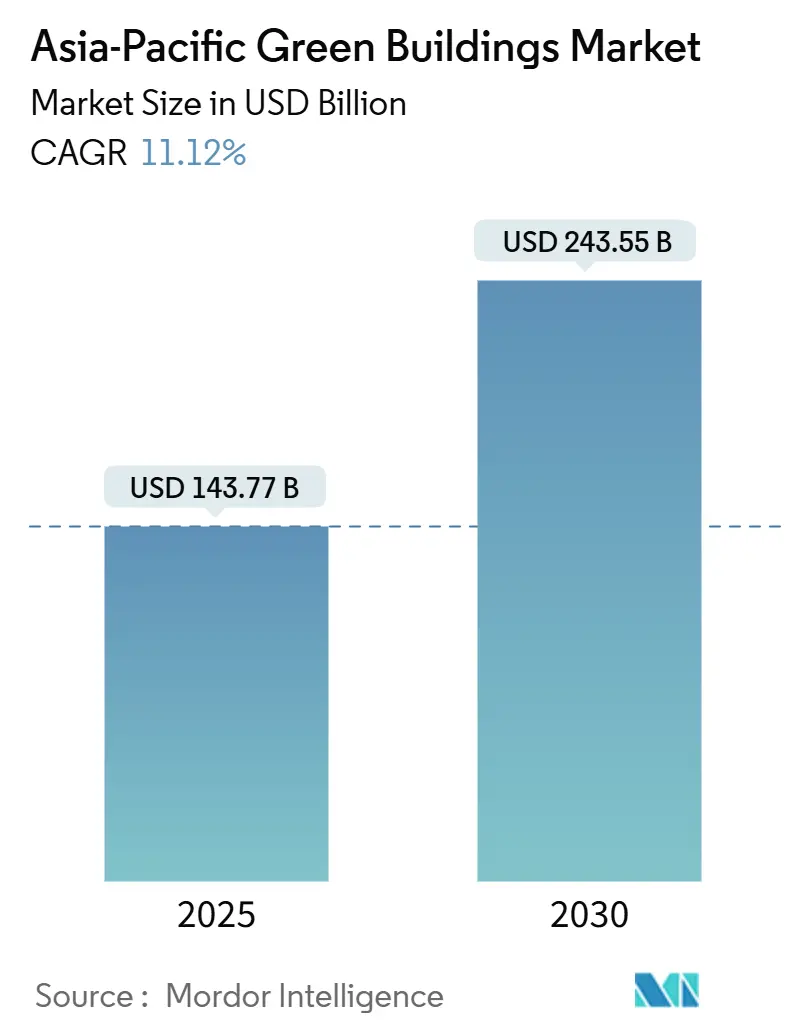
Asia-Pacific Green Buildings Market Analysis by Mordor Intelligence
The Asia-Pacific Green Buildings Market size is estimated at USD 143.77 billion in 2025, and is expected to reach USD 243.55 billion by 2030, at a CAGR of 11.12% during the forecast period (2025-2030). Heightened policy stringency, sustained corporate net-zero pledges, and the tangible cost of energy volatility now position green specifications as baseline project requirements rather than premium add-ons. China retains scale leadership, while India’s accelerating 13.02% CAGR underscores a geographic pivot toward fast-growing South Asian demand centers. Building systems integration, smart-HVAC adoption, and maturing green finance underpin robust supplier pipelines that dilute the impact of short-term supply chain friction. Competitive intensity remains moderate as certification hurdles favor incumbents, yet digital disruptors are reshaping value capture through performance-as-a-service models.
Key Report Takeaways
- By product type, Building Systems led with 41.2% of the APAC Green Buildings market share in 2024; the segment is forecast to advance at an 11.91% CAGR through 2030.
- By end user, the Residential segment controlled 55.6% of the APAC Green Buildings market size in 2024, while Commercial applications are projected to grow at a 12.21% CAGR to 2030.
- By construction stage, New Construction accounted for 66.1% of the APAC Green Buildings market size in 2024, but Renovation is on track for the fastest 12.75% CAGR over the forecast period.
- By country, China led with 38.1% of the APAC Green Buildings market share in 2024, while India is forecast to advance at a 13.02% CAGR through 2030.
Asia-Pacific Green Buildings Market Trends and Insights
Drivers Impact Analysis
| Drivers | (~) % Impact on CAGR Forecast | Geographic Relevance | Impact Timeline |
|---|---|---|---|
| Strengthening building-energy codes, green standards, and long-term decarbonization targets | +2.8% | China, Japan, South Korea core, expanding to India and Indonesia | Medium term (2-4 years) |
| Corporate ESG/net-zero commitments driving portfolio-wide upgrades | +2.1% | Global, with highest concentration in Japan, Australia, Singapore | Short term (≤ 2 years) |
| Energy price volatility and emphasis on lifecycle operating cost reductions | +1.9% | APAC-wide, particularly acute in import-dependent markets | Long term (≥ 4 years) |
| Expanding green finance (tax incentives, green bonds, sustainability-linked loans) | +1.6% | Singapore, Hong Kong financial hubs, spreading to mainland markets | Medium term (2-4 years) |
| Market preference for certified assets, supporting rent and valuation premiums | +1.4% | Primary cities across APAC, led by Tokyo, Sydney, Singapore | Medium term (2-4 years) |
| Source: Mordor Intelligence | |||
Strengthening Building-Energy Codes Drive Compliance-Led Growth
Mandatory codes such as China’s GB 55015-2021, Japan’s revised Building Energy Efficiency Act, and India’s 2024 Energy Conservation Building Code enlarge the addressable pool of projects that must integrate green technologies by statute. Developers now incorporate performance modeling during concept design because non-compliance risks project approval delays, and resale limitations. Prefabricated façade makers and smart-HVAC suppliers consequently enjoy more stable order books, prompting capacity expansions that ease unit-cost pressures. Provincial authorities in China further subsidize post-occupancy energy audits, reinforcing the shift from construction-stage criteria to in-use performance metrics. The cumulative effect is a self-reinforcing ecosystem in which regulation, verification, and procurement standards accelerate the APAC Green Buildings market beyond voluntary adoption[1]Takashi Saito, “Building Energy Efficiency Act Revision 2024,” Ministry of Land, Infrastructure, Transport and Tourism, mlit.go.jp.
Corporate ESG Mandates Transform Portfolio Strategies
CapitaLand’s net-zero carbon pledge and Swire Properties’ USD 1.2 billion sustainability-linked loan exemplify how financing terms now hinge on measurable building performance. Executive compensation at leading Asian developers is tied to the Science Based Targets initiative milestones, embedding decarbonization goals in corporate governance. Large multinationals leverage standardized building assessment templates that cascade to local supply chains, forcing subcontractors to upgrade capabilities or face disqualification. Cross-portfolio procurement of high-efficiency chillers and smart sensors yields volume discounts, lowering adoption thresholds for smaller projects. The resulting network effects expand the APAC Green Buildings industry’s serviceable obtainable market well beyond marquee flagship developments[2]Lynette Leong, “Sustainability Master Plan 2030,” CapitaLand, capitaland.com.
Energy Cost Volatility Accelerates Lifecycle Value Recognition
Electricity spot-price swings in Australia and prospective carbon taxes in Singapore have recalibrated tenant negotiations toward total occupancy cost, not just base rent. Payback periods for integrated energy-management systems have shortened to three to five years, catalyzing CFO sign-off for capital expenditure. Institutional investors now incorporate modeled operational-expense scenarios into valuation, penalizing assets with poor energy intensity that could become stranded. Indonesian subsidy phase-outs by 2030 signal that fossil-fuel cost pass-through will rise, further amplifying demand for certified systems. In aggregate, energy price uncertainty functions as a persistent tailwind to the APAC Green Buildings market.
Green Finance Mechanisms Enable Capital Formation
Hong Kong’s Green and Sustainable Finance Grant Scheme reimburses verification costs, enabling first-time issuers to access bond markets at competitive rates. Singapore’s Green Finance Incentive Scheme and Japan’s TCFD-aligned disclosure rules funnel mainstream capital into verifiable low-carbon assets, lowering the weighted-average cost of capital by 40–60 basis points. The Asian Development Bank’s USD 100 billion climate-finance pledge earmarks concessional debt for green-building projects, derisking private participation in emerging markets. On-bill repayment pilots in Malaysia align loan amortization with realized utility savings, eliminating up-front cost barriers for smaller owners. These mechanisms collectively lift the capital-formation ceiling, fueling the APAC Green Buildings market expansion[3]Yvonne Tsui, “Green and Sustainable Finance Grant Scheme,” Hong Kong Monetary Authority, hkma.gov.hk.
Restraints Impact Analysis
| Restraints | (~) % Impact on CAGR Forecast | Geographic Relevance | Impact Timeline |
|---|---|---|---|
| Higher upfront capital costs and uncertain payback in secondary markets | -1.4% | Indonesia, India secondary cities, emerging APAC markets | Short term (≤ 2 years) |
| Skills shortages and uneven availability of certified materials/technologies | -1.2% | Regional, particularly acute in Southeast Asia and India | Medium term (2-4 years) |
| Fragmented regulations, split incentives, and inconsistent valuation practices across jurisdictions | -0.9% | Cross-border projects, multi-jurisdiction developments | Long term (≥ 4 years) |
| Source: Mordor Intelligence | |||
Capital Cost Premiums Constrain Secondary-Market Adoption
In Indonesia, cost premiums of up to 30% persist due to imported façade components and limited local testing facilities. Smaller banks price higher risk premiums into construction loans because resale benchmarks for certified buildings remain thin outside capital cities. Developers compromise on specification depth to preserve pro-forma returns, diluting environmental outcomes and market perception. Absent robust secondary-market data, valuation professionals default to conservative appraisal assumptions, perpetuating financing challenges. This dynamic tempers near-term APAC Green Buildings market penetration in price-sensitive locales.
Skills Gaps and Supply Chain Constraints Limit Execution Capacity
The region faces a projected shortfall of 400,000 certified professionals by 2030, straining commissioning and verification schedules. Contractors must often fly in specialists from mature markets, inflating budgets and elongating project cycles. Uneven availability of smart-building components creates lead-time unpredictability, complicating synchronized project delivery. Training curricula lag rapid technology evolution, widening the proficiency gap in advanced analytics and renewable-energy integration. These bottlenecks impose friction costs that shave points off the APAC Green Buildings market growth curve.
Segment Analysis
By Product Type: Systems Integration Drives Market Leadership
Building Systems commanded 41.2% of the APAC Green Buildings market share in 2024, and the segment is expected to escalate at an 11.91% CAGR through 2030. This growth stems from intelligent HVAC platforms that apply artificial-intelligence algorithms for predictive maintenance and real-time load balancing, delivering measurable reductions in energy intensity. Suppliers integrate on-site solar, battery storage, and demand-response capabilities, enabling buildings to act as flexible grid participants rather than static consumers. Exterior Products follow in scale as building-envelope innovations combine thermal resistance with aesthetic versatility suited to diverse climatic zones. Interior Products advance occupant-wellness attributes, such as low-VOC materials and circadian lighting, aligning with post-pandemic health expectations. An emergent “Others” cluster, including building-integrated photovoltaics, underscores a pipeline of disruptive materials that will continue to reshape the APAC Green Buildings market.
Integrated platforms also lower commissioning complexity by consolidating controls under unified dashboards, a feature increasingly valued by facilities-management teams tasked with meeting escalating reporting obligations. Standardized digital twins facilitate remote performance auditing, strengthening post-handover service revenues for system vendors. As carbon-pricing schemes spread, tariff-optimized control algorithms become critical differentiators in procurement tenders, amplifying the competitive moat around integrated Building Systems providers. Although Exterior and Interior Products maintain momentum, their annual gains trail the flagship Systems category, which now represents the core revenue engine of the APAC Green Buildings market.
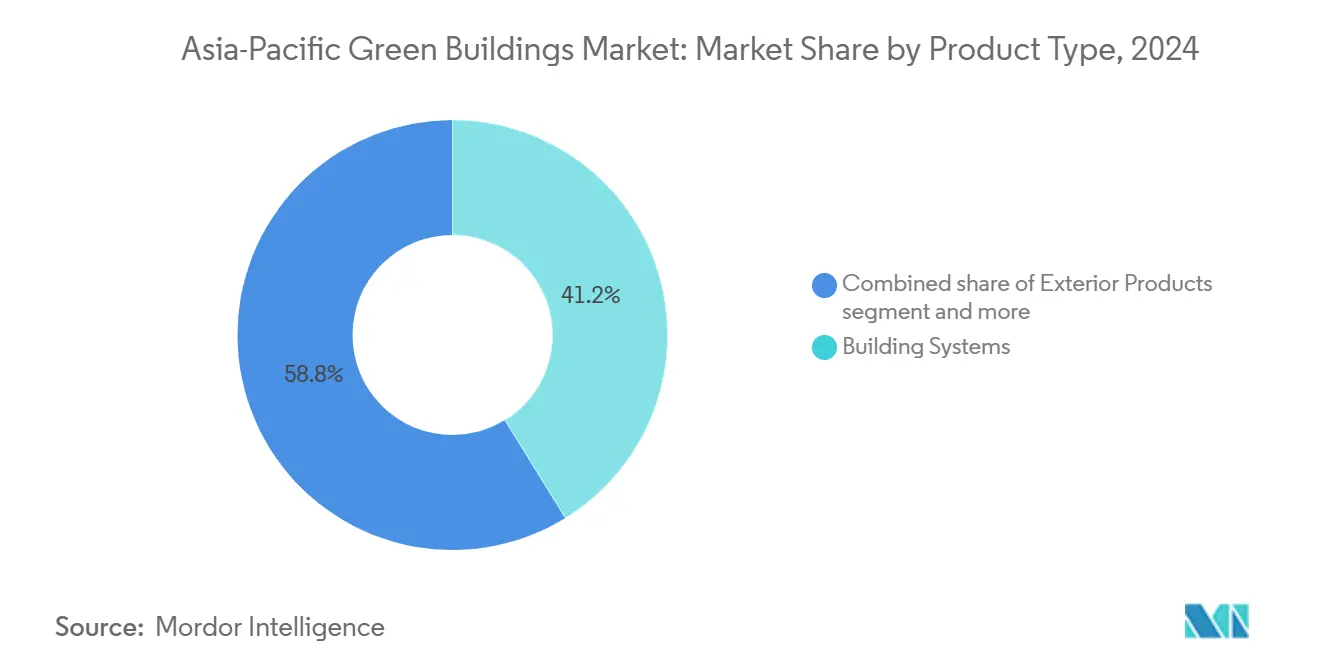
Note: Segment shares of all individual segments available upon report purchase
By End User: Commercial Acceleration Challenges Residential Dominance
The Residential segment maintained 55.6% of the APAC Green Buildings market size in 2024, but Commercial applications are forecast for the fastest 12.21% CAGR through 2030. Commercial offices lead new demand as tenants negotiate performance-indexed leases that link rent escalation to energy-intensity thresholds. Institutional investors prefer assets pre-qualified for green or wellness certification, converting sustainability credentials into tangible exit-premium expectations. Retail centers retrofit LED and smart-climate controls to counter margin compression from e-commerce and rising utility tariffs. Logistics operators, under pressure from global e-commerce platforms to decarbonize supply chains, upgrade warehouse shells with reflective roofing and on-site solar, deepening the Commercial adoption curve.
Residential growth persists, driven by large-scale condominium projects in China and India that leverage standardized green-spec templates to achieve volume cost advantages. Government-linked mortgage rebates for certified buildings in Singapore and Japan further reinforce buyer preference. Still, the relative acceleration of Commercial demand shifts supplier focus toward scale-neutral solutions adaptable across multi-tenant footprints. As corporate sustainability disclosures become mandatory, Commercial real estate is likely to anchor incremental expansion in the APAC Green Buildings market beyond 2027.
By Construction Stage: Renovation Economics Improve Rapidly
New Construction accounted for 66.1% of the APAC Green Buildings market size in 2024, reflecting ongoing urban-expansion pipelines. Yet Renovation projects, advancing at a 12.75% CAGR, now capture attention from financiers seeking lower embodied-carbon footprints. Regulatory frameworks in Japan and Australia offer tax incentives for performance upgrades that surpass new-build baselines, tilting internal rate-of-return calculations in favor of retrofits. Prop-tech-enabled energy audits illuminate specific, high-ROI interventions such as heat-recovery chillers or dynamic glazing, reducing technical risk perceptions. On-bill financing schemes in Korea and trial energy-service-company contracts in Thailand remove upfront-capital barriers, opening renovation to asset owners without large cap-ex budgets.
Materials suppliers introduce modular retrofit kits that minimize occupant disruption, vital for income-producing assets unwilling to endure extended downtime. Carbon-accounting protocols increasingly factor embodied emissions, giving renovation an advantage that becomes more pronounced as regional carbon budgets tighten. While greenfield projects retain share due to continuing population growth, the faster CAGR underscores a structural pivot toward extending and decarbonizing existing building stock, solidifying renovation’s role as a mainstream growth pillar for the APAC Green Buildings market.
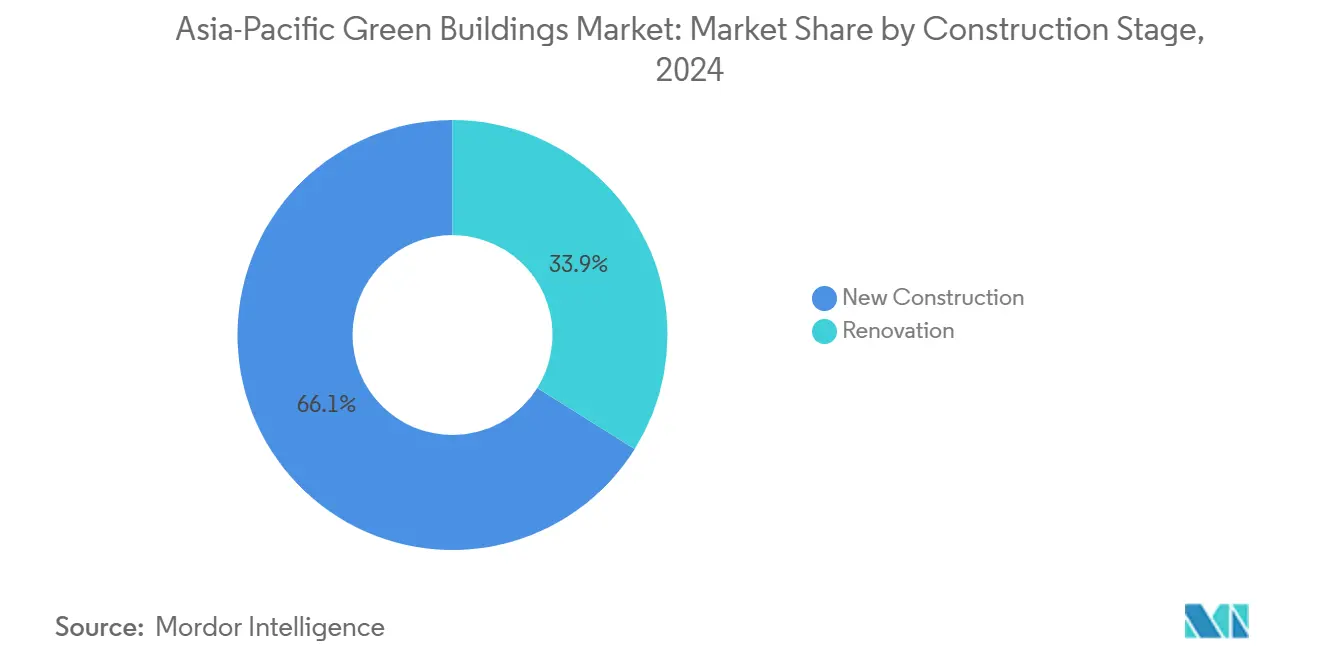
Geography Analysis
China’s 38.1% share positions the country as the anchor tenant of the Asia-Pacific Green Buildings market, underpinned by economies of scale in domestic component supply and top-down enforcement of mandatory efficiency codes. Yet as the construction cycle matures, growth pivots from quantity to quality, prioritizing operational-performance enhancements over pure capacity expansion. India is expected to register a 13.02% CAGR through 2030, buoyed by rapid urbanization and mandatory commercial-building energy codes that expand the compliance base. State-level incentives, such as Maharashtra’s floor-space-index bonuses for certified projects, augment national policy, adding depth to the pipeline.
Japan and South Korea exhibit advanced-market behaviors marked by innovation in smart-building controls, resilience features, and post-occupancy verification services. These capabilities are increasingly export to Southeast Asia via joint ventures and technology-licensing agreements, diffusing expertise across borders. Australia folds climate-resilience requirements into existing energy-efficiency mandates, triggering demand for systems that handle both heat waves and extreme rainfall.
Emerging economies, notably Indonesia and Vietnam, experience policy liberalization that welcomes blended-finance models linking multilateral climate funds with local-currency debt. Supply-chain localization initiatives aim to reduce import dependencies observed during pandemic disruptions. However, uneven enforcement and workforce constraints moderate penetration speed. Collectively, geographic diversity amplifies total addressable opportunity while necessitating region-specific go-to-market playbooks for participants in the APAC Green Buildings market.
Competitive Landscape
Competitive intensity remains moderate: certification barriers and capital requirements shield incumbents, yet digitization lowers entry thresholds for nimble software-centric challengers. Integrated contractors such as Shimizu Corporation extend market reach by acquiring smart-building specialists, exemplified by its USD 180 million purchase of GreenTech Solutions in August 2024. Traditional developers increasingly form alliances with equipment makers to deliver bundled performance guarantees, signaling convergence between construction and service segments.
Technology-first disruptors monetize recurring analytics subscriptions, capturing data-layer value traditionally overlooked in lump-sum construction contracts. This service orientation shifts competition toward lifetime-performance credentials rather than the lowest up-front cost. Regional fragmentation persists: Chinese firms dominate domestic value chains, Japanese integrators lead high-specification niches, and Australian contractors excel in resilience-oriented retrofits.
Financial innovation further reshapes rivalry as sustainability-linked instruments reward operational excellence with lower interest margins, favoring players able to document energy reductions. Cross-border environmental-attribute trading, still nascent, could enable portfolio-level optimization spanning multiple jurisdictions, reinforcing the strategic importance of scalable digital-monitoring infrastructures. The ongoing pivot from one-off builds to life-cycle partnerships is likely to recalibrate market share dynamics in the APAC Green Buildings market by 2030.
Asia-Pacific Green Buildings Industry Leaders
-
Lendlease
-
Keppel Land
-
Shimizu Corporation
-
Swire Properties
-
Gammon Construction
- *Disclaimer: Major Players sorted in no particular order
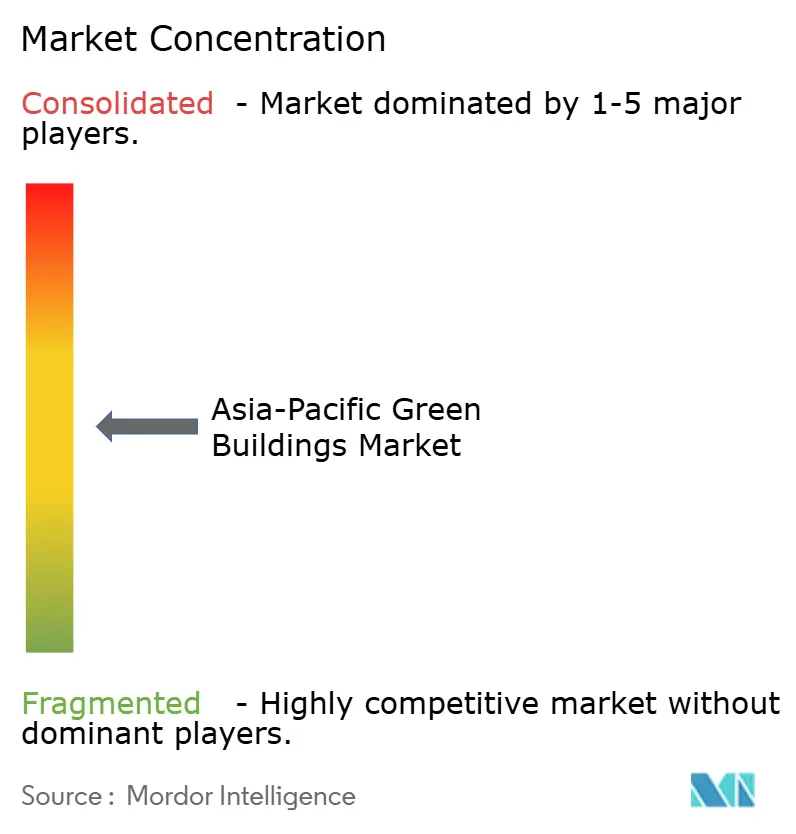
Recent Industry Developments
- September 2024: Blackstone partnered with Travelodge Asia to acquire and convert a Seoul office tower into a mid-scale hotel, marking its strategic entry into Korean hospitality conversions.
- September 2024: China State Construction Engineering Corporation announced a USD 1.2 billion green building project in Jakarta, Indonesia. The mixed-use sustainable complex, featuring photovoltaics, rainwater harvesting, and smart grid connectivity, targets LEED and GREENSHIP Platinum certifications with completion by 2027.
- August 2024: Shimizu Corporation acquired a 60% stake in Singapore-based smart-building firm GreenTech Solutions for USD 180 million to enhance Southeast-Asian performance-optimization services.
- June 2024: Keppel Land and Mitsubishi Estate formed a USD 800 million joint venture to develop green residential projects across Japan and Singapore, blending Southeast-Asian development expertise with Japanese technology.
Asia-Pacific Green Buildings Market Report Scope
The green building market is for buildings designed, built, and operated sustainably. This includes buildings with energy efficiency, renewable energy, water efficiency, waste reduction, and indoor environmental quality.
The APAC green buildings market is segmented by product (exterior products, interior products, others (building systems, solar systems, etc.)), by end user (residential, office, retail, institutional, other end users), by geography (China, Japan, India, Australia, South Korea, and the Rest of APAC). The report offers market size and forecasts for the APAC green buildings market in value (USD) for all the above segments.
| Exterior Products |
| Interior Products |
| Building Systems |
| Others |
| Residential | Apartments & Condominiums |
| Villas & Landed Houses | |
| Commercial | Office |
| Retail | |
| Logistics | |
| Institutional | |
| Others (industrial real estate, hospitality real estate, etc.) |
| New Construction |
| Renovation |
| China |
| India |
| Japan |
| South Korea |
| Australia |
| Indonesia |
| Rest of Asia-Pacific |
| By Product Type | Exterior Products | |
| Interior Products | ||
| Building Systems | ||
| Others | ||
| By End User | Residential | Apartments & Condominiums |
| Villas & Landed Houses | ||
| Commercial | Office | |
| Retail | ||
| Logistics | ||
| Institutional | ||
| Others (industrial real estate, hospitality real estate, etc.) | ||
| By Construction Stage | New Construction | |
| Renovation | ||
| By Country | China | |
| India | ||
| Japan | ||
| South Korea | ||
| Australia | ||
| Indonesia | ||
| Rest of Asia-Pacific | ||
Key Questions Answered in the Report
What is the current value of the APAC green-construction opportunity?
The APAC Green Buildings market size stands at USD 143.77 billion in 2025 with a projected expansion to USD 243.55 billion by 2030.
Which country is growing the fastest in sustainable-building adoption?
India leads with a 13.02% CAGR through 2030, propelled by mandatory energy-code enforcement and rapid urbanization.
Which product category holds the largest revenue in the region?
Building Systems represent 41.2% of 2024 revenue, driven by smart-HVAC and integrated energy-management platforms.
Why are renovation projects attracting more capital now?
Improved payback periods, regulatory incentives, and modular retrofit technologies push renovation to a 12.75% CAGR, faster than new-builds.
Page last updated on:
